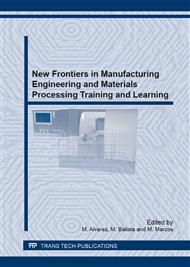[1]
D. Woods, Wikis for dummies, John Wiley, USA (2007)
Google Scholar
[2]
G. Domínguez Fernández, L. M. Torres Barzabal, E. López Menese, Aprendizaje con wikis. Usos didácticos y casos prácticos, (Eduforma, Spain 2010)
Google Scholar
[3]
C. León de Mora, Entornos colaborativos en docencia virtual: redes sociales y wikis, (Universidad de Sevilla, Spain 2010)
Google Scholar
[4]
D. Bell, The Wiki Handbook: THE How To on Wiki, Complete Expert's Hints and Tips Guide by the Leading Experts, Everything You Need to Know About Wiki, (Christopher-Gordon Publishing, Australia 2009)
Google Scholar
[5]
R. Beach, C. Anson, L. Kastman Breuch, T. Swiss, Teaching writing using blogs, wikis, and other digital tools (Christopher-Gordon Publishers, USA 2009).
Google Scholar
[6]
T.B. Chatfield, The Complete Guide to Wikis: How to Set Up, Use, and Benefit from Wikis for Teachers, Business Professionals, Families, and Friends, (Atlantic Publishing Company, USA 2009)
Google Scholar
[7]
S. Martínez-Pellitero, J. Barreiro, A.I. Fernández-Abia, Tools for teaching-learning of Manufacturing Engineering using content management platforms, Materials Sci. Forum, Vol. 692 (2011), p.104.
DOI: 10.4028/www.scientific.net/msf.692.104
Google Scholar
[8]
C. Leadbeater, We-Think: Mass innovation, not mass production, (Profile Books, 2009).
Google Scholar
[9]
W. Richardson, Blogs, Wikis, Podcasts and Other Powerful Web Tools for Classrooms, (Corwin Press, USA 2009)
DOI: 10.4135/9781506314686
Google Scholar
[10]
J. West, Using wikis for online collaboration: the power of the read-write Web, (Jossey-Bass, USA 2011)
Google Scholar
[11]
T. Burrows, Blogs, Wikis, MySpace, and More: Everything You Want to Know About Using Web 2.0 but Are Afraid to Ask, (Chicago Review Press, USA 2008)
Google Scholar
[12]
R. Palomo López, Uso de los wikis en educación. En: Enseñar con TIC en el siglo XXI: la escuela 2.0, Editorial MAD, Madrid, (2008)
DOI: 10.29057/xikua.v6i11.2777
Google Scholar
[13]
P. Chinnowsky, H. Brown, A. Szajnman, A. Realph, Developing knowledge landscapes through project-based learning, Journal of Professional Issues in Engineering Education and Practice, Vol. 2 (2006), pp.118-125.
DOI: 10.1061/(asce)1052-3928(2006)132:2(118)
Google Scholar
[14]
G. Padmanadhan, D. Katti, Using community-based projects in civil engineering capstone courses, Journal of Professional Issues in Engineering Education and Practice, Vol. 1 (2002), pp.12-18.
DOI: 10.1061/(asce)1052-3928(2002)128:1(12)
Google Scholar
[15]
C. Parsons, E. Caylor, H. Simmons, Cooperative Education Work Assignments The role of Organizational and Individual Factors in Enhancing ABET Competencies and Co-op Workplace Well-Being, Journal of Engineering Education, Vol. 3 (2005), pp.309-316.
DOI: 10.1002/j.2168-9830.2005.tb00855.x
Google Scholar
[16]
W. Kelly. Certification and Accreditation in Civil Engineering, Journal of Professional Issues in Engineering Education and Practice, Vol. 3 (2007), pp.181-187.
DOI: 10.1061/(asce)1052-3928(2007)133:3(181)
Google Scholar


